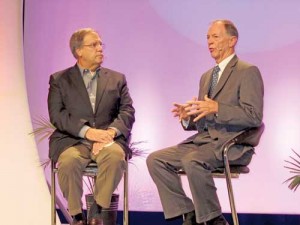by Dave Weiman

HARTFORD, CONN. – FAA Administrator Randy Babbitt told pilots and aircraft owners at the AOPA Summit, September 23, 2011, that he is concerned with the rising accident rate in general aviation, and has initiated a study to get to the bottom of it. He hopes that by changing FAA written test standards and aeronautical knowledge training, that this will help. Of the 195 GA accidents this past year, 114 had fatalities. In his presentation, the Administrator did not consider any decrease in hours flown as a possible cause of accidents.
“I want to focus on professionalism in the cockpit,” said Babbitt. The Administrator plans to seek input from flight schools in developing the new standards.
The Administrator is also directing a program to help the industry better explain the role of GA airports to the public.
Concerning “NextGen,” or the modernization of the air traffic control system, Babbitt wants GA aircraft owners to equip their aircraft, sooner rather than later, and noted the benefits in doing so.
“I don’t have a switch in the back room to just turn it on,” said Babbitt, but he noted the safety and efficiency of installing equipment for ADS-B in and out. ADS-B out will be required by 2020. There is no timeline to require ADS-B in, but the FAA is working on that, he said.
The Administrator noted the savings aircraft owners will realize in getting aviation weather without having to pay for a subscription. He believes this will offset the cost of the equipment required. Babbitt did not comment on aircraft owners who cannot afford weather subscriptions, which are currently available, nor how they will be unable to pay for ADS-B equipment.
Babbitt said that with ADS-B in and out, more airspace will be available to those aircraft owners who own that equipment. The reverse will likely be true for those owners who cannot afford the equipment…there will be less airspace available to them.
“The more equipment you have, the more access you will have to airspace,” said Babbitt.
“One of the great features of ADS-B in and out is that it provides radar coverage where radar coverage was not available before,” said Babbitt.
Another benefit of NextGen will be the pilot’s ability to fly “profile descents,” from as high as 35,000 feet, requiring only power adjustments. Delta Airlines is already saving on average 60 gallons of fuel per approach, noted Babbitt.
AOPA President Craig Fuller stated that he feels that modernization will need to be done in stages.
“Let’s build confidence (in the system),” said Fuller.
The FAA has no plans to install any new Instrument Landing System (ILS) equipment at airports, said Babbitt. Each ILS costs $3 million to install, and a lot of maintenance thereafter. WAAS GPS approaches are much more cost-effective, said Babbitt.
Fuller raised concern over the White House’s proposal to create “user fees” to help reduce the deficit, and asked Babbitt if approved by Congress, just how such a plan would be implemented.
Babbitt responded: “It’s a little early to get excited about the Red Skins going to the Super Bowl,” implying that President Obama will have a difficult time getting his proposal through Congress. Instead, the FAA is trying to find cost-saving measures within the agency, so that user fees – other than what aircraft owners currently pay through the federal fuel tax – will not be necessary.